Restorative dental care consists of various ways your dentist can replace missing teeth or repair missing parts of the tooth structure.
Tooth structure can be missing due to decay, deterioration of a previously placed restoration, or fracture of a tooth. We strive to deliver the most conservative restorative dental care to correct damaged teeth. We utilize laser imaging technology called Diagnodent to find very early decay, so we can repair it with minimally invasive bonding composite.
We will recommend the best, most long-lasting options but we also offer the least expensive, reasonable alternatives when appropriate for the budget-minded, should that be your preference.
Examples of restorations include the following:
 “Gummy smiles” are a very common problem, caused by overgrowth of the gum tissue that covers the teeth. This unsightly occurrence can be caused by a variety of things, including heredity, health conditions and even the use of many common high blood pressure medications. A gummy smile will dominate the mouth, making the teeth seem almost secondary in appearance. We use a laser to change the look and shape of the gums. The laser actually vaporizes unnecessary and unsightly tissue with unmatched accuracy and effectiveness. What is left in the place of the overgrown gums is a healthy-looking, well-proportioned smile. The process takes only a few minutes for most, and there is usually very little discomfort.
“Gummy smiles” are a very common problem, caused by overgrowth of the gum tissue that covers the teeth. This unsightly occurrence can be caused by a variety of things, including heredity, health conditions and even the use of many common high blood pressure medications. A gummy smile will dominate the mouth, making the teeth seem almost secondary in appearance. We use a laser to change the look and shape of the gums. The laser actually vaporizes unnecessary and unsightly tissue with unmatched accuracy and effectiveness. What is left in the place of the overgrown gums is a healthy-looking, well-proportioned smile. The process takes only a few minutes for most, and there is usually very little discomfort.
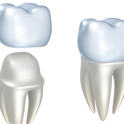 The most common crown restoration placed today utilizes a metal lining covered with porcelain. These types of restorations are not as natural in appearance because light is not able to pass through porcelain-metal crowns as it does with a natural tooth. The result is an opaque or flat-looking tooth. Often, these types of traditional crowns leave a dark or gray line next to the gum line. Our talented team is proud to offer a natural-looking alternative: all-ceramic, nonmetal crowns! With these newer restorations you will notice the life-like appearance that mimics natural teeth and does not produce the black gum line so common with porcelain-metal crowns.
The most common crown restoration placed today utilizes a metal lining covered with porcelain. These types of restorations are not as natural in appearance because light is not able to pass through porcelain-metal crowns as it does with a natural tooth. The result is an opaque or flat-looking tooth. Often, these types of traditional crowns leave a dark or gray line next to the gum line. Our talented team is proud to offer a natural-looking alternative: all-ceramic, nonmetal crowns! With these newer restorations you will notice the life-like appearance that mimics natural teeth and does not produce the black gum line so common with porcelain-metal crowns.
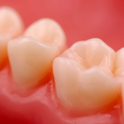 Fillings are the most common type of dental restoration. Teeth can be filled with gold or silver amalgam, but metal amalgams can damage teeth. Temperature sensitive, metal amalgams expand with heat and contract with cold. This movement weakens the tooth wall, leading to fractures, and also allows bacteria to enter and cause decay. They also contain mercury, which may have negative long-term health effects. Tooth-colored composite fillings are a safer, stronger, more attractive and a more enduring alternative to metal.
Fillings are the most common type of dental restoration. Teeth can be filled with gold or silver amalgam, but metal amalgams can damage teeth. Temperature sensitive, metal amalgams expand with heat and contract with cold. This movement weakens the tooth wall, leading to fractures, and also allows bacteria to enter and cause decay. They also contain mercury, which may have negative long-term health effects. Tooth-colored composite fillings are a safer, stronger, more attractive and a more enduring alternative to metal.
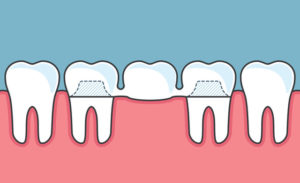
Bridges are false teeth that are designed to bridge the gap created by one or more missing teeth. Bridges can be anchored on either side by crowns and cemented permanently into place
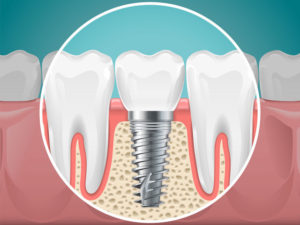
Implants are replacement tooth roots. Implants are actually a small post made of metal that are placed into the bone socket where teeth are missing. The implant is covered with a replacement tooth called a crown.
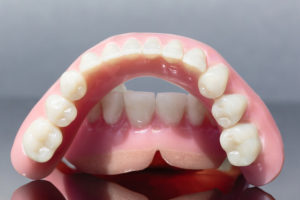
Dentures are a removable replacement for missing teeth and surrounding tissues. They are made of acrylic resin sometimes combined with metal attachments. Complete dentures replace all the teeth; partial dentures are considered when some natural teeth remain and are retained by metal clasps attached to the natural teeth.
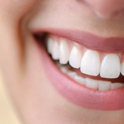 Metal fillings are not the healthiest solution, often expanding and contracting with temperature changes. This can cause cracking or allow bacteria to cause further decay. Inlays and onlays make it possible to replace older defective silver fillings with beautiful and healthy tooth-colored restorations. We’ll design them to match your teeth, reviving your natural strength, wear and function. With new materials such as pure porcelain, it really is finally possible to beautifully repair and restore your smile.
Metal fillings are not the healthiest solution, often expanding and contracting with temperature changes. This can cause cracking or allow bacteria to cause further decay. Inlays and onlays make it possible to replace older defective silver fillings with beautiful and healthy tooth-colored restorations. We’ll design them to match your teeth, reviving your natural strength, wear and function. With new materials such as pure porcelain, it really is finally possible to beautifully repair and restore your smile.
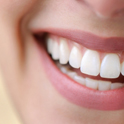 Worn, discolored or gapped teeth can be embarrassing and can affect your self-esteem and confidence. Bonding is the perfect solution. Inexpensive and conservative, bonding uses a tooth-colored composite material to restore teeth and enhance smiles. The composite is placed on the tooth, then shaped and molded to achieve the desired results, including: whitening, closing spaces between teeth, making teeth appear straighter and repairing chips and cracks. The material is then hardened and polished, creating a natural appearance.
Worn, discolored or gapped teeth can be embarrassing and can affect your self-esteem and confidence. Bonding is the perfect solution. Inexpensive and conservative, bonding uses a tooth-colored composite material to restore teeth and enhance smiles. The composite is placed on the tooth, then shaped and molded to achieve the desired results, including: whitening, closing spaces between teeth, making teeth appear straighter and repairing chips and cracks. The material is then hardened and polished, creating a natural appearance.
 Headache treatment at the dentist? Yes! A high percentage of headaches are muscle related and the most common muscles to be affected are the chewing muscles. We have successfully treated chronic headaches, migraines and morning tension headaches, often with no medication or injections. A properly trained dentists is in a unique position to evaluate and treat this type of headache pain, and this is certainly a most rewarding part of our practice. If you suffer from frequent or debilitation headaches, contact our office for an evaluation today.
Headache treatment at the dentist? Yes! A high percentage of headaches are muscle related and the most common muscles to be affected are the chewing muscles. We have successfully treated chronic headaches, migraines and morning tension headaches, often with no medication or injections. A properly trained dentists is in a unique position to evaluate and treat this type of headache pain, and this is certainly a most rewarding part of our practice. If you suffer from frequent or debilitation headaches, contact our office for an evaluation today.
 Porcelain veneers are the most conservative aesthetic restorations available in dentistry today. A thin layer of the front of the tooth is removed to allow porcelain to be bonded to the tooth without making it any thicker. The veneer covers dark or yellow teeth, fills unsightly gaps, lengthens short or stubby teeth and straightens crooked teeth. Veneers offer a lasting solution. The veneers are attached to the teeth using the most advanced bonding technology. The end result is a strong, functional, natural-looking and beautiful smile!
Porcelain veneers are the most conservative aesthetic restorations available in dentistry today. A thin layer of the front of the tooth is removed to allow porcelain to be bonded to the tooth without making it any thicker. The veneer covers dark or yellow teeth, fills unsightly gaps, lengthens short or stubby teeth and straightens crooked teeth. Veneers offer a lasting solution. The veneers are attached to the teeth using the most advanced bonding technology. The end result is a strong, functional, natural-looking and beautiful smile!
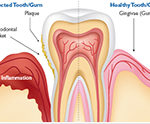
We take pride in helping you to achieve and maintain a healthy periodontal. Gum inflammation may result from inadequate or ineffective home care and can be aggravated by poor tooth alignment and ill-fitting restorations. Gum disease results in inflammation and places your entire immune system on high alert and can affect premature birth, diabetes-control, heart conditions, and other systemic health matters.
Over time, gum inflammation can progress and destroy the bone that supports your teeth. We routinely examine for bone loss to enable early, effective, non-surgical treatment. With improved home care and regular supportive care, we are confident we can establish a healthy environment which promotes oral and systemic health.
